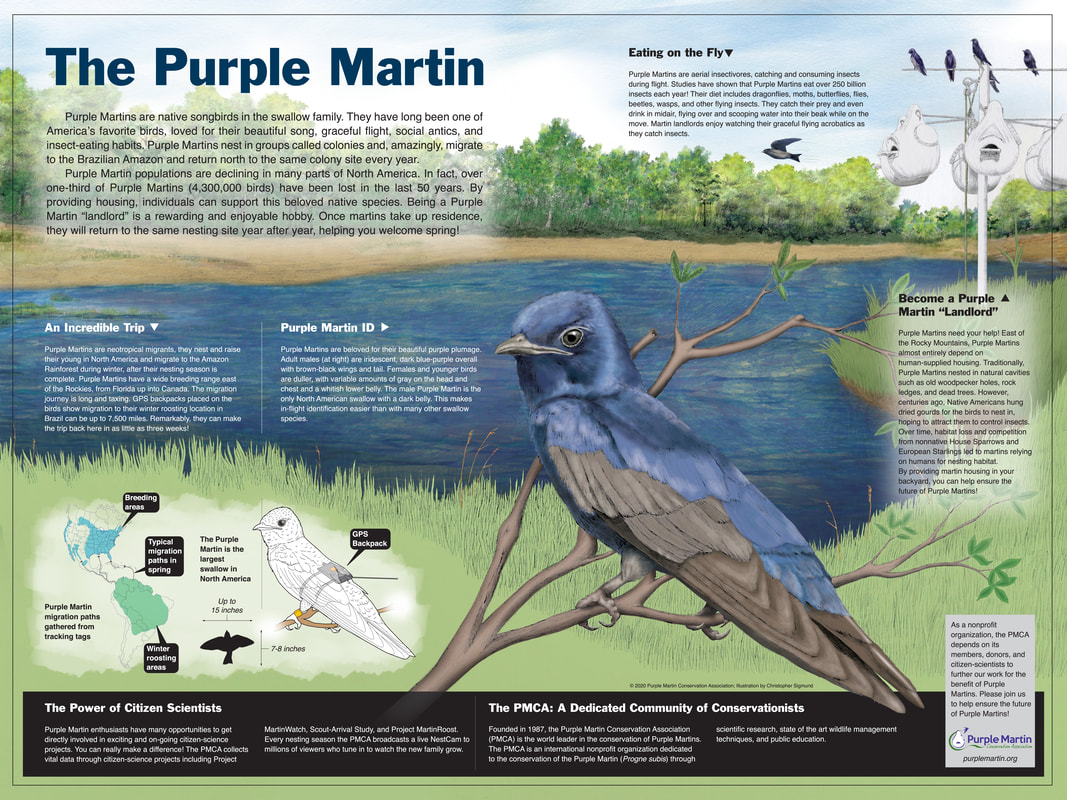Introduction
The Purple Martin Conservation Association (PMCA) is a 501 (c) 3 nonprofit organization dedicated to the conservation of Purple Martins through scientific research, state of the art management techniques, and public education, with the end goal of increasing martin populations throughout North America. Local volunteers monitor the Purple Martin house on a weekly basis from April through August each year in the park. They follow the PMCA procedure known as “Project MartinWatch”, where they lower the Purple Martin house each week, check the contents of each cavity, and record what they find. During a nest check, volunteers collect data such as nesting dates, number of eggs laid, how many eggs hatch, and how many nestlings successfully fledge. Monitoring the colony is the best way to detect, and help prevent, problems such as predation, parasites, and premature fledging. Data is submitted at the end of each season to the PCMA, adding to a database of tens of thousands of reports documenting the changes in Purple Martin nesting over the years across the United States.
Some facts to consider
Click on the THOUGHT QUESTIONS button below to learn more and test your knowledge about Purple Martins.
Select the other buttons to learn more about protecting Purple Martins and their nesting habitats.
The Purple Martin Conservation Association (PMCA) is a 501 (c) 3 nonprofit organization dedicated to the conservation of Purple Martins through scientific research, state of the art management techniques, and public education, with the end goal of increasing martin populations throughout North America. Local volunteers monitor the Purple Martin house on a weekly basis from April through August each year in the park. They follow the PMCA procedure known as “Project MartinWatch”, where they lower the Purple Martin house each week, check the contents of each cavity, and record what they find. During a nest check, volunteers collect data such as nesting dates, number of eggs laid, how many eggs hatch, and how many nestlings successfully fledge. Monitoring the colony is the best way to detect, and help prevent, problems such as predation, parasites, and premature fledging. Data is submitted at the end of each season to the PCMA, adding to a database of tens of thousands of reports documenting the changes in Purple Martin nesting over the years across the United States.
Some facts to consider
- Purple Martins are the largest member of the swallow family in North America. They have a short slightly hooked beak, broad chest, and forked tail. Their flight pattern is typical of swallows, short glides with longer alternating flapping.
- One of the most important steps in attracting Purple Martins is choosing the right location for your martin housing. Martins prefer housing that is placed in open areas with clear flyways, close to human housing. East of the Rockies, martins nest almost exclusively in human-supplied housing.
- Martins are aerial insectivores, consuming insects during flight. Dragonflies are a favorite as well as moths, butterflies, flies, beetles, wasps, and other flying insects.
Click on the THOUGHT QUESTIONS button below to learn more and test your knowledge about Purple Martins.
Select the other buttons to learn more about protecting Purple Martins and their nesting habitats.








